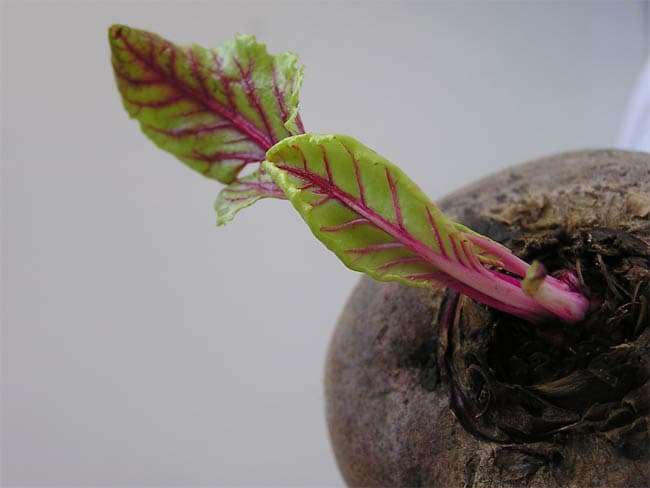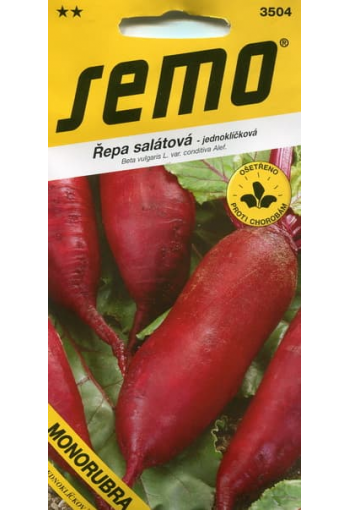Ex Tax: 57.75€
A variety with cylindrical shape of the bulb. The single-germity of the seeds makes it possible to grow the plants from direct sowings without thinning.
A mono-germ, mid-late to late variety. The bulbs are cylindrical; the flesh is red with no rings. The plant is moderately vigorous. Sow in April for harvesting for immediate consumption and from May until June for harvesting for preserving. The growing time from sowing to harvest is 130 days.


Eng.: Beetroot. Suom.: Punajuurikas. Sven.: Rödbeta.
Beets are a valuable vegetable crop. Beet roots are well stored, so they can be consumed fresh all year round.
Beets are relatively drought-resistant, and not very demanding on soil fertility. Increased need for moisture - only in the initial stage of growth, before the formation of a leaf rosette. At the same time, beetroot does not tolerate waterlogging of the soil - root crops acquire an unpleasant taste and plants become prone to diseases.
Soil preparation. Since autumn, the soil is deeply dug up, and 3 kg of superphosphate and 2 kg of potassium sulfate or ash are added to it. In the spring, the soil is shallowly dug up. Beets should be planted 2-3 years after fresh manure or compost is applied. By mid-May, it is time to sow beets.
The culture seems to have long been known, as unpretentious. But it also has its secrets. For example, beets are very demanding on light but are salt-tolerant, that is, they grow well on saline soils.
With dense plantings, with weak thinning, even round varieties can stretch, which should not be allowed.
Beet seeds are seedlings formed as a result of the fusion of 3-5 flowers, each seedling has 3-5 seeds, so seedlings appear in nests. Single-fruited varieties appeared: when one seed gives only one sprout (!).
The optimum soil temperature for seed germination is 11 degrees. At temperatures below four degrees, the seeds do not germinate but do not lose their germination capacity in the soil. Seedlings withstand temperatures down to minus 3-4 degrees, root crops endure temperatures down to minus 1-2 degrees. At lower temperatures, they freeze slightly and then rot during storage. The optimum air temperature for plant growth is 15-23 degrees.
Requirements of beets to moisture are especially great in the initial period of development. Mature plants are hardier, as their root system penetrates to a greater depth. However, with a lack of moisture, the flesh of the root crop coarsens and the leaves are crushed and dry prematurely. Beets grow very poorly with excess moisture and acidification of the soil. Therefore, it should not be sown on heavy, acidic and waterlogged soils.
Beets are very demanding on the light. In case of insufficient sunlight, in the shade of trees, shrubs or buildings, with strong thickening in the rows and aisles, and when overgrown with weeds, the plants stretch and form a very small root crop. It is not recommended to apply large doses of mineral fertilizers, especially nitrogen fertilizers, since beets accumulate nitrates greatly. It is better to limit yourself to humus. Beets sown on May 15-20 will sprout by the beginning of June. Watering should be done carefully so as not to wash the seedlings.
The main work at this time, as, indeed, with other root crops, is thinning. It is necessary that between the plants from the first days of germination there was a distance of 1-2 cm. The second thinning should be combined with selective harvesting at the end of July.
Between plants of beets, radishes, turnips and parsnips, it is desirable to maintain a distance of 8-10 cm. It does not make sense to leave large distances between root crops, as they will grow strongly and will be tasteless.
Regular watering is necessary for root crops during their formation. With a long break in watering, the tissues harden, and when watering or rain is resumed, the roots crack. With a weak development of plants, top dressing is effective in furrows up to 4 cm deep along the rows at a distance of 7 cm from the plants. On the one hand, granulated superphosphate is introduced into the grooves, on the other hand, urea mixed with potassium chloride (10 g per 1 m of length). After fertilizing, the soil must be watered. If there is no mineral fertilizer, ash can be added to the soil.
The appearance of yellow round spots on beet leaves indicates that the soil is acidic and lacks potassium. In this case, it is necessary to water the plant with milk of lime mixed with potassium chloride (300 g of lime and 80 g of potassium chloride per 10 litres of water per 20 m of length).











